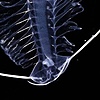HOME | DD
 artbyjrc — Comb-thorns - Ctenacanths
artbyjrc — Comb-thorns - Ctenacanths

#cretaceous #devonian #elasmobranch #fish #permian #shark #ctenacanth #glikmanius #bandringa #kaibabvenator #saivodus #dracopristis #goodrichthys #wodnika
Published: 2022-05-15 09:51:53 +0000 UTC; Views: 36292; Favourites: 380; Downloads: 49
Redirect to original
Description
A selection of extinct elasmobranchs known as ctenacanths, to scale.
Preceding the arrival of true sharks (superorder Selachii) during the Triassic, there were several orders of shark-like elasmobranchs which were present in both marine and freshwater environments. Apart from a generalised shark-like body form, these early groups commonly have dorsal fin spines, a feature also seen in some true sharks (living bullhead sharks). Two of these ancient elasmobranch groups have been covered previously (see Eel-sharks - Xenacanths and Spiny protosharks - Hybodonts ), which leaves the ctenacanths.
As with most fossil elasmobranchs, ctenacanths are generally known from teeth, very little skeletal material and the fin spines. Ctenacanth spines are recognisable by their distinctive comb-like ornamentation. Although not a distinguishable feature across all species they generally had flat jaws and large mouths compared to true sharks. Fossils are known from the Late Devonian through to the Early Cretaceous.
Dominating the Early Carboniferous seas was the giant Saivodus. It reached lengths of up to 8.5 metres long, extrapolated from a large specimen which included skull material and 6 cm long teeth (larger than a Great white shark's teeth). Another much smaller species, Dracopristis, was nicknamed Godzilla shark due to the array of long spines and shape of the teeth. Well preserved and articulated skeletons show that it had multi-pronged teeth used to grip and cruch prey, such as fish and cephalopods. Although not commonly found in the Permian, a ctenacanth assemblage from the Kaibab Formation in Arizona shows niche partioning between the various species. They include the puncturing teeth of the smaller Glikmanius which was able to catch and eat prey whole, while the large Kaibabvenator had serrated cutting teeth for feeding on any prey item. Bearing a long rostrum reminscent of the unrelated sawfish's toothed snout, Bandringa was the most bizarre member of the ctenacanths. Opposed to modern elasmobranchs, adult Bandringa lived and spawned in freshwater environments, while young fish migrated downriver to brackish water. As mentioned in Brush-fins + unicorn spines - Symmoriids several chondrichthyan groups have been shown to exhibit sizeable fossil gaps from the Permian until the Early Cretaceous. Fossils of Heslerodus-like ctenacanths have been discovered from deep water sites in France and Austria. Deep water habitats have commonly been a refuge for shallow water groups during periods of catastrophic change: gyrancanthid acanthodians, conodonts, latimeriid coelacanths all feature deep water species following sizeable gaps in the fossil record.
Edit: Image of Bandringa has been reduced to a third of the original, based on more accurate information.
Related content
Comments: 39

👍: 0 ⏩: 0

👍: 2 ⏩: 1

👍: 1 ⏩: 1

👍: 0 ⏩: 0

👍: 1 ⏩: 1

👍: 0 ⏩: 1

👍: 1 ⏩: 0

👍: 1 ⏩: 1

👍: 2 ⏩: 0

👍: 2 ⏩: 1

👍: 1 ⏩: 0

👍: 2 ⏩: 1

👍: 3 ⏩: 1

👍: 1 ⏩: 0

👍: 2 ⏩: 1

👍: 3 ⏩: 0

👍: 1 ⏩: 1

👍: 0 ⏩: 0

👍: 0 ⏩: 1

👍: 1 ⏩: 1

👍: 1 ⏩: 1

👍: 1 ⏩: 1

👍: 1 ⏩: 1

👍: 1 ⏩: 1

👍: 1 ⏩: 0

👍: 1 ⏩: 1

👍: 0 ⏩: 0

👍: 1 ⏩: 0

👍: 1 ⏩: 1

👍: 0 ⏩: 1

👍: 1 ⏩: 1

👍: 0 ⏩: 1

👍: 1 ⏩: 1

👍: 1 ⏩: 0

















